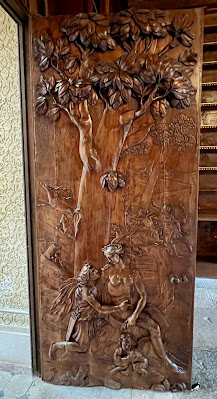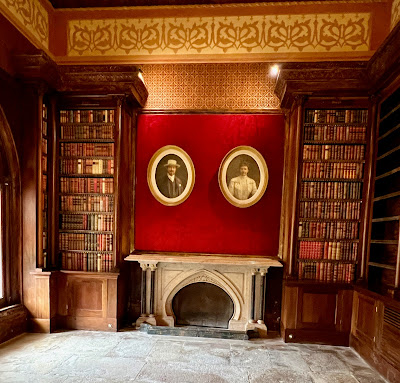Sintra reminds me of a fairytale town with a fantasy kingdom and enchanted forest. Sintra is where the Celta worshiped the moon, the Moors built their "great wall" and royalty erected their dream palaces.
I needed to get myself from Cascais to Sintra. My strategy seemed very simple:
1) eat complimentary breakfast at the Pergola Hotel in Cascais,
2) go back to my room to pack,
3) check-out of the Pergola and
4) make my way to the local bus station to find bus #403, the local bus to Sintra.
The bus station is located below the Cascais Villa Shopping Mall. I found no escalators or elevators to take me down to the bus level so I had to schlep my luggage down a flight of stairs.
 |
| Cascais Villa Shopping Mall behind train station |
The stairs to the bus station are located just to the left of the blue tower. The #403 departs every 30 minutes throughout the day, seven days a week. The first bus from Cascais is 8:40am and from Sintra is at 9am. The last one from Sintra is at 7:40pm and from Cascais is at 8:40pm. There are NO trains that operate between Cascais and Sintra.
 |
| Bus stop sign for bus #403 |
 |
| Front view of bus #403 |
I arrived at the bus station at 12:30p but unfortunately bus #403 was just pulling out of the station. I had to wait another 30 minutes for the next bus. I boarded the 1:00pm bus and arrived in Sintra at 1:50pm. Along the route the bus makes a stop at Cabo da Roca.
Cabo da Roca is located 9 miles north from Cascais, 11 miles west of Sintra and 25 miles west of Lisbon. The route follows scenic N247 and leaves at the village of Azoia. The route is well signed and is a further 2 miles from the village. Bus #403 is the preferred transportation between Cascais and Sintra and is operated by Scotturb. A single ticket cost 4.30 euros and is purchased from the driver. From Cascais the bus takes 22 minutes. From Sintra it takes 37 minutes to reach Cabo da Roca.
The Cabo da Roca is a wild and rugged headland that marks the most westerly point of mainland Europe. Even today there is an isolated ambience to Cabo da Roca. There is little development in the area. There is a lighthouse, a coffee shop and a gift shop but not much else.
 |
| Lighthouse Photo: Public Domain |
 |
| Cliffs of Cabo da Roca Photo: Public Domain |
There is no entrance fee or parking charges. A typical tourist bus would spend 15-30 minutes here which is plenty of time to view the cliffs, take photos of the monument and see the lighthouse. The lighthouse is not open to the public. For a novel gift you can purchase a personalized and handwritten certificate confirming you visited Cabo da Roca.
Note: This is an exposed headland. Expect bracing winds and significantly cooler weather than in Cascais or Sintra.
I arrived in Sintra just before 2pm. My stay would be 2 nights at the Hotel Nova Sintra. From the bus station in Sintra I walked to the hotel, about 300 meters slightly uphill on uneven cobbled streets.
Once I found the street entrance to the hotel I was surprised to see that I had to further negotiate a significant number of steps with my luggage.
 |
| Steps up to the registration desk |
I left Marci with my luggage and walked up the steps, in the front door and was greeted by Rui, the hotel owner, at the registration desk. I asked if someone could assist with luggage and immediately Rui darted down the steps, greeted Marci at the bottom and took all of our luggage upstairs. He assigned room #1, located on the first floor right next to the registration desk and breakfast seating area.
The remainder of the afternoon was spent walking the streets enjoying the feel of the city.
Breakfast at the Hotel Nova was served at 8:30am and consisted of pasteries, cereals, yogurts, coffees and a nice assortment of breads, meats and cheeses.
Sintra offers local transportation to all the major points of interest.
I purchased 2 all-day passes for the hop on hop off bus #434 at a total cost of 23 euros.
MONSERRATE PALACE
An
Arabian inspired villa with intricate latticework, stone carvings and tranquil
gardens. I boarded bus #434 at 9:30am and got off at the Monserrate Palace stop. I spent 2 hours here between the walk to the Palace and the actual tour itself. Entrance fee was 8 euros per person. The walk down to the palace was about 500 meters through a garden area.
 |
| Gate Entrance to Monserrate Palace |
 |
| Monserrate Palace |
 |
| Scale model of Monserrate Palace |
 |
| Hand carved wooden doors |
 |
| Selfie - Waiting at Monserrate for bus #434 back to Sintra |
MOORISH CASTLE
The Moorish Castle was built by the Moors in the 8th and 9th centuries. After the conquest of Lisbon in 1147 the castle surrendered voluntarily to Christian forces. In 1995 it was classified as a National Monument and part of the Sintra Cultural Landscape, a UNESCO World Heritage Site.

Moorish Castle Walls Photo: Public Domain
The walk from the main road down to the castle entrance is about 500 meters. Entrance fee was 8 euros for adults or 6.50 euros for seniors. Due to the weather conditions the castle was covered with a thick heavy fog the day of my visit. Even with the fog it was a beautiful experience.
 |
| Small museum on the way to the castle |
After a full day of sightseeing and lots of walking, it was time to head back to the hotel for a good nights sleep. Tomorrow would bring another travel day in Portugal, starting with a train to the northern city of Porto, Portugal.












































No comments:
Post a Comment